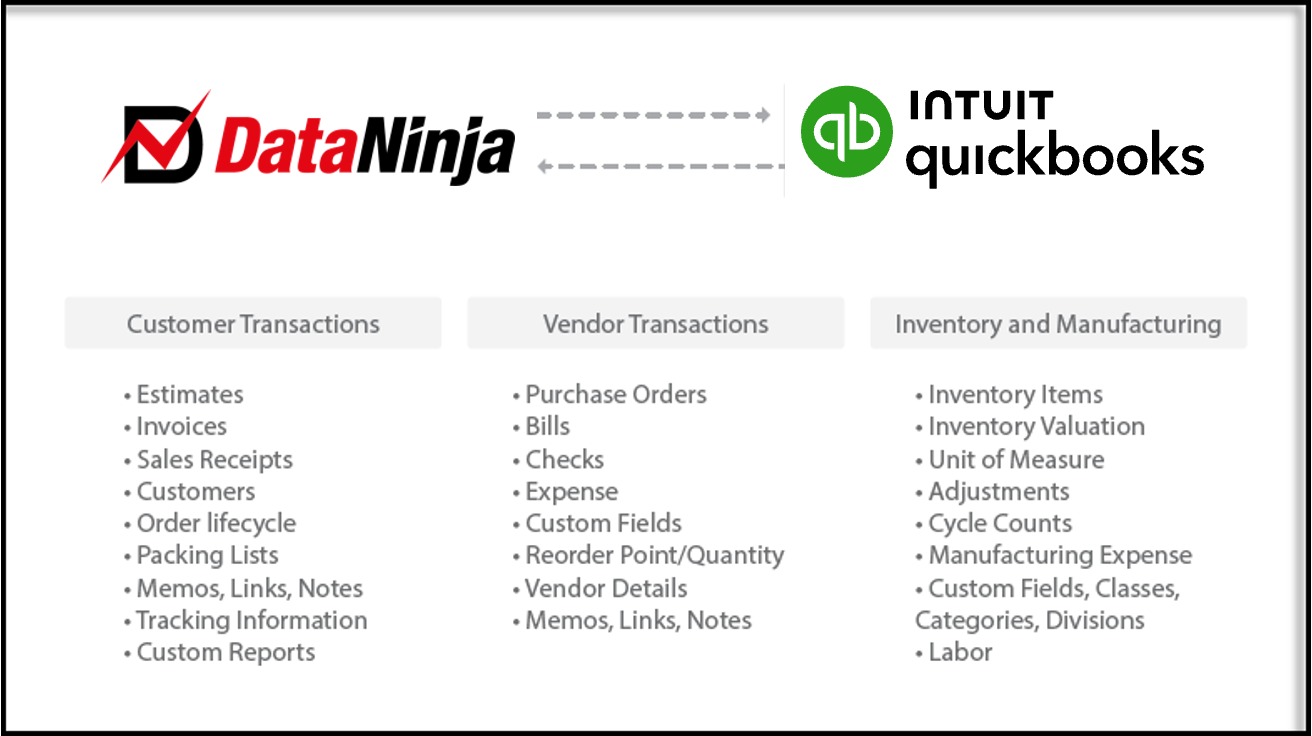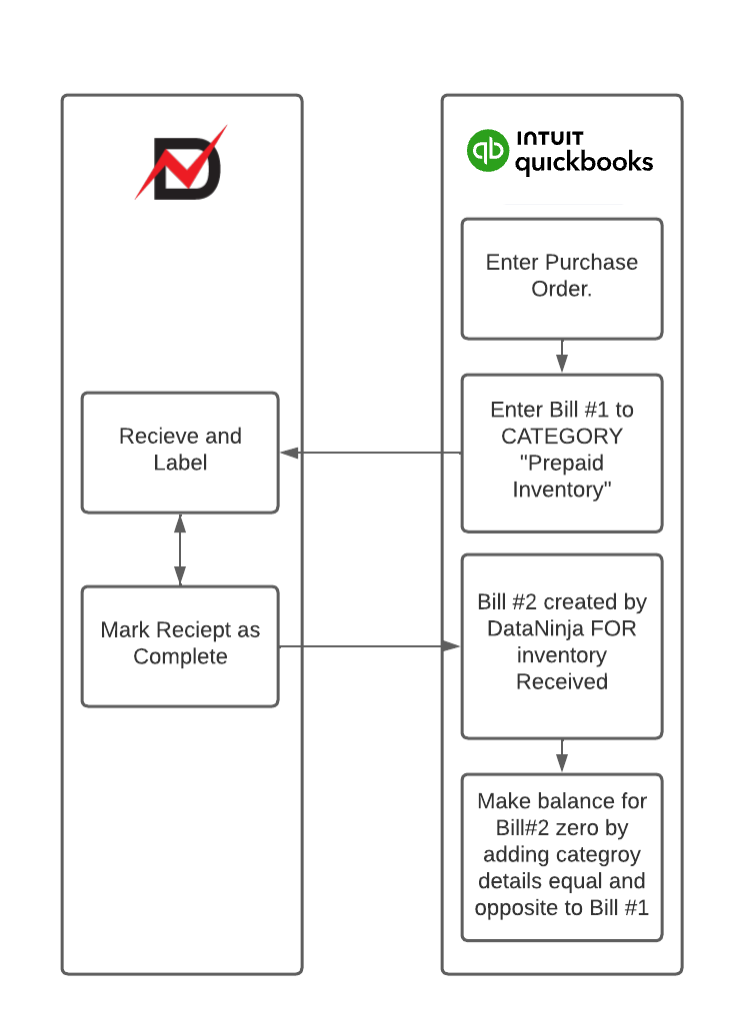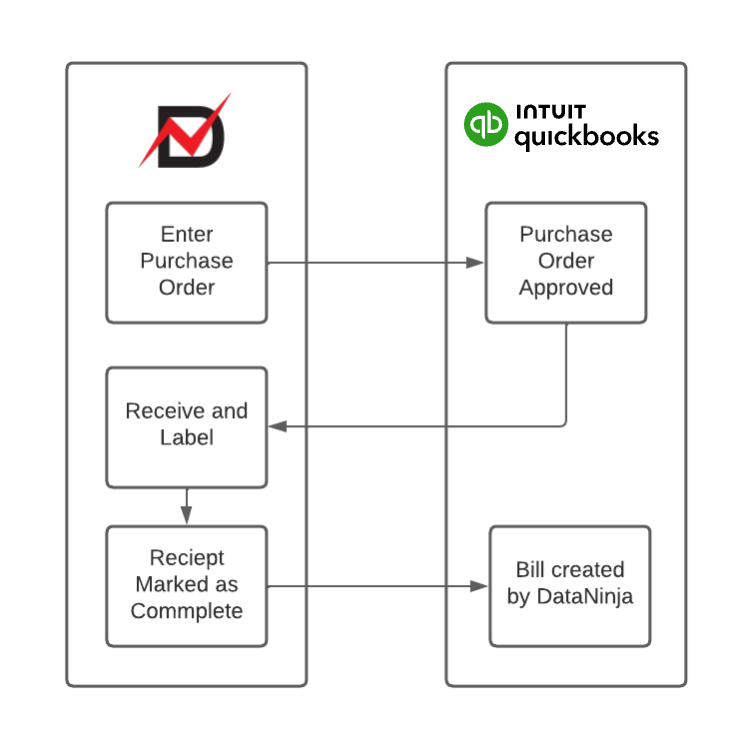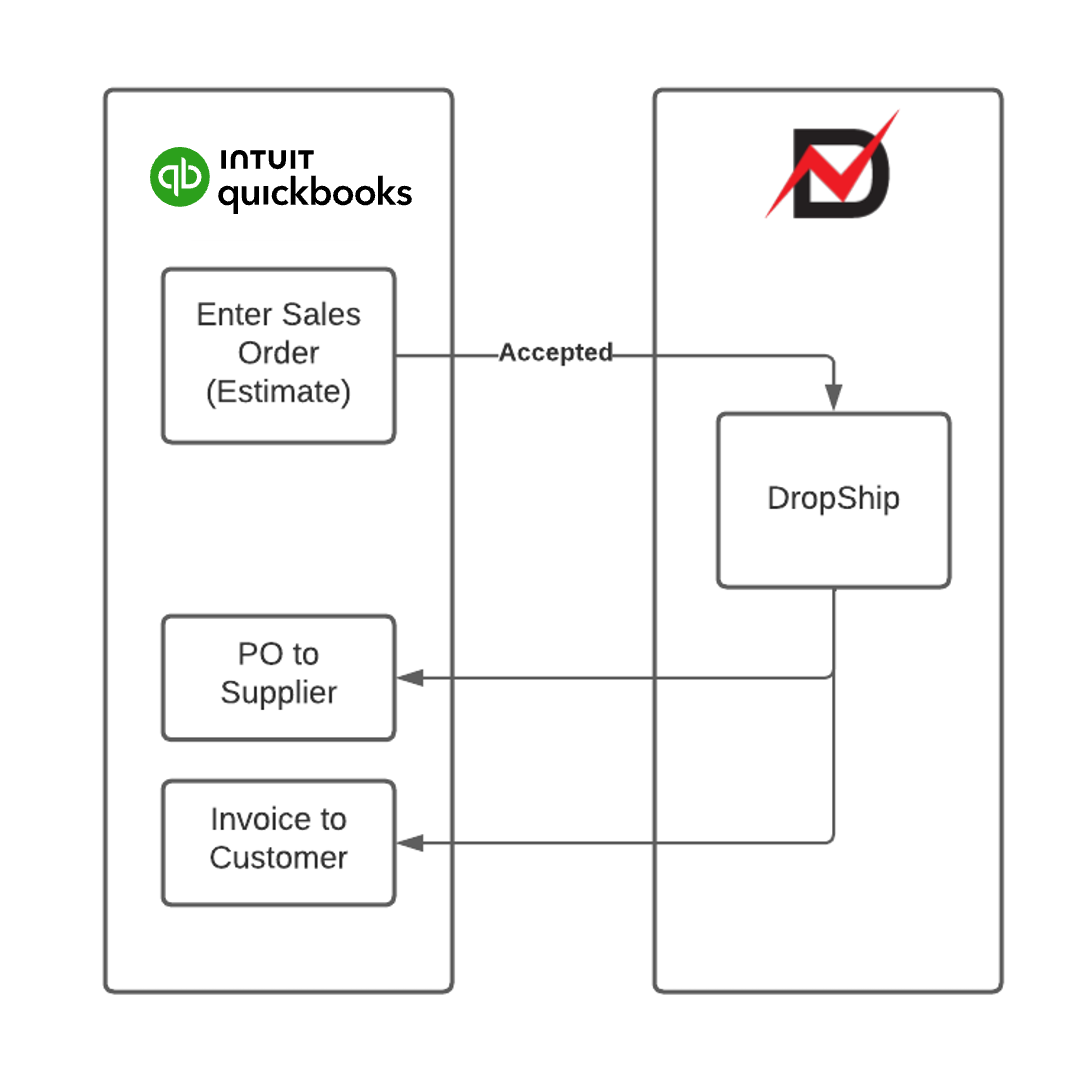DataNinja + QuickBooks Online Sync Overview
How/Where/When information is pushed between systems
DataNinja and QuickBooks Online sync bidirectionally. Sync flows summarized in this article are the most common/recommended integration touchpoints between QuickBooks Online and DataNinja.

Parts and Inventory Items
The following data fields sync bidirectionally between DataNinja Parts and QuickBooks Online Inventory Items. Based on user permissions changes to any these linked fields in one system will result in an update to the other.
| DataNinja Part | QuickBooks Online Inventory Item |
|---|---|
| Part Number | Name |
| Description | Description |
| UPC | SKU |
| Reorder Point | Reorder Point |
| Part Class | Category |
| Standard Cost | Cost |
| Standard Price | Sales Price |
| Preferred Vendor | Preferred Vendor |
Other item/part fields influence how inventory transactions are pushed between systems but one side of the sync is the owner of the master data. Item Lot Tracking, Warehouse flow, and Quality Details are maintained by DataNinja. Financial accounts for inventory item transactions are maintained by QuickBooks Online.
Fields Owned by DataNinja
- Unit Set (Units of Measure and Conversions)
- Tracking Type
- Shelf Life
- Reorder Quantity
- Purchasing Class
- Sales Class
- Default Receiving Inventory Location
- Part Lifecycle
- Default Lot Quality Status (Quarantine vs Released)
Fields Owned by QuickBooks Online
- Inventory Item Asset Account
- Inventory Item Expense Account
- Inventory Item Income Account
- Direct Labor and Overhead Account
- Manufacturing Clearing Account
Raw Material Purchases (Procure to Pay Workflow Variants)
Purchase Order, Bill, Expense, and Check are each inventory purchase transactions that sync from QuickBooks into DataNinja. Use Purchase Orders whenever possible. Although Purchase Orders can be originated in either system, it is best practice to create Purchase Orders for Raw Materials within QuickBooks. The following are the most common sync flows for inventory purchasing between QuickBooks and DataNinja.
Workflow A: Raw materials purchased from Vendor with Terms
- Purchase Order Entry in QuickBooks pushes into DataNinja
- Receive in DataNinja - print labels, preform quality inspection
- Marking receipt complete pushes payable (Bill) for received quantities into QuickBooks
Blanket PO's or dealing with supplier partial deliveries?Create multiple receipts against the same order. Each completed receipt syncs to QuickBooks as its own payable (Bill).
Workflow B: Raw Materials Paid for in Advance of Receipt
If you are required to pay for your raw material in full before it is received, record the purchase in QuickBooks as a Purchase Order. Also enter a Bill to document vendor prepayment. The Bill entered for prepayment must use the Category section of the Bill. NOT the Items section.

- Record inventory intent to purchase as a Purchase Order in QuickBooks.
- Enter Bill #1 to document cash spent for pre-payment. USE CATEGORY of Bill.
- Receive in DataNinja - print labels, preform quality inspection.
- Marking receipt complete pushes payable (Bill #2) for received quantities into QuickBooks.
- Edit Bill #2 to pull from vendor prepaid Bill#1, making balance of Bill #2 zero.
Why is Pre-Payment so tricky?Accurate accounting of prepayments for inventory are a hassle because you don't get the inventory when you pay for it. You need to account for pre-payment as a current asset that is NOT inventory, then back that value INTO inventory asset as soon as it is received. This is the best way to accurately track full and partial prepayments.
Workflow C: Partial Payment to Vendor at Order, Remaining at Receipt
- Record inventory intent to purchase as a Purchase Order in QuickBooks.
- Enter Bill #1 to document cash spent for pre-payment. USE CATEGORY of Bill.
- Receive in DataNinja - print labels, preform quality inspection.
- Marking receipt complete pushes payable (Bill #2) for received quantities into QuickBooks.
- Edit Bill #2 to pull from vendor prepaid Bill#1, making balance of Bill #2 the remaining payment required.
Workflow D: Purchase Order Creation From DataNinja
- PO created from Order More option in DataNinja MRP
*The following workflow steps are the same as Workflow A above - Purchase Order Entry in QuickBooks pushes into DataNinja.
- Receive in DataNinja - print labels, preform quality inspection.
- Marking receipt complete pushes payable (Bill) for received quantities into QuickBooks.
Recipe, Formula, Bill of Materials
Formulas are created, revision controlled and updated in DataNinja only. QuickBooks Online does not currently have the ability to store Bill of Materials information. These details are recorded in DataNinja only. DataNinja Bill of Materials combine Recipe with Routing (Including Quality and Workcenter Costing) and Quality approvals. A DataNinja BOM is the Master Manufacturing Quality Record.

Quality Record Templates (Incoming QC, and Sampling Plans)
Quality control inspections and sampling plans are managed in DataNinja. Inventory values are communicated with QuickBooks in real-time, independent of quality release approvals and inspection records.
Raw Materials: Use Incoming Inspection
Produced Materials ( Sub Assemblies and Finished Goods) : Use Acceptable Quality Level (AQL) Sampling Plans.
Production Cost Accounting
DataNinja helps QuickBooks account for manufacturing on a run-by-run basis. The asset value of each produced lot is directly tied to the costs of inventory used and labor performed.
DataNinja costing includes:
- Fixed and Variable Labor
- Fixed and Variable Scrap
- Outside processing costs
- Consumption and Yield variances
- Purchase price variances (Landed Cost)
-
Schedule Manufacturing Record.
-
Record Actual Consumption and Yield.
-
E-sign Manufacturing Record (Batch Record).
-
Expense Generated in QuickBooks. Dollar value of inputs shifted to produced inventory value in QuickBooks.

Customer Sales (Quote to Cash Workflow Variants)
Sales Order (Estimate), Invoice and Sales Receipt are each inventory sale transactions that sync from QuickBooks into DataNinja. Use Sales Orders whenever possible. In QuickBooks Online, Sales Orders are called Estimates. Invoices can be originated in either system. When entering customer orders directly as Invoices it is best practice to create Invoices within QuickBooks. The following are the most common sync flows for customer sales between QuickBooks and DataNinja.
Why are Purchase Orders and Sales Orders Best? Its all about timing.Using these non-posting transaction types allows you to acknowledge orders immediately, but account for the financial impact at the right moment - when inventory is actually transacted in the real world.
Sales Workflow A: Enter Order as Sales Order, Invoice Customer Upon Shipment
-
Enter customer order in QuickBooks as an Estimate (Sales Order).
-
When the Estimate is marked "Accepted" in QuickBooks it will sync into DataNinja as a fillable Sales Order. (This step is optional. If desired, Estimates can be synced as soon as they are created.)
-
Pick, scan to pack, and mark shipment(s) complete in DataNinja.
-
DataNinja generates invoice in QuickBooks. Packing List with Lot Numbers, and other custom documents (COA) attached to invoice in QuickBooks.

Sales Workflow B: Customer Pays in Full via ACH Prior to Shipment
- Enter customer order in QuickBooks Estimate
- When the customer has paid. Mark the Estimate as Accepted.
- Pick, scan to pack, and mark shipment(s) complete in DataNinja -this generates an Invoice in QuickBooks.
- Mark invoice generated in QuickBooks as Paid (Wire or ACH transfer already hit bank)
Edit your QuickBooks Estimate TemplateChange the wording on your Estimate Template to use "Invoice"
Sales Workflow C: Customer Pays Partial Prior to Shipment. Remainder Paid on Terms
- At Point of Order
- Enter Customer Order using Inventory Item Details AS ESTIMATE
- Enter Invoice for Non-Inventory "Prepayment" or "Order Deposit for..."
- When the customer pays prepayment Invoice. Mark Estimate as accepted (Triggers sync to DataNinja)
- Pick, scan to pack, and mark shipment(s) complete in DataNinja -this generates an Invoice in QuickBooks.
- Deduct deposit from Invoice Balance. Only remaining balance is due from customer.
- Send Invoice to Customer.
Sales Workflow D: Dropship (Sell-Buy-Ship)
- Enter customer order as a Sales Order (Estimate) in QuickBooks. Sync to DataNinja.
- Select "MRP for Orders".
- "Add Drop Ship".
- Creates supplier Purchase Order and Bill.
- Creates customer Invoice.
Direct Links

Click on the QuickBooks logo with DataNinja to go directly to the associated transaction in QuickBooks Online. Linked transactions include:
Inventory Receiving
Manufacturing
Shipping
View the DataNinja App Listing on the QuickBooks Online Marketplace.
Updated about 2 months ago
